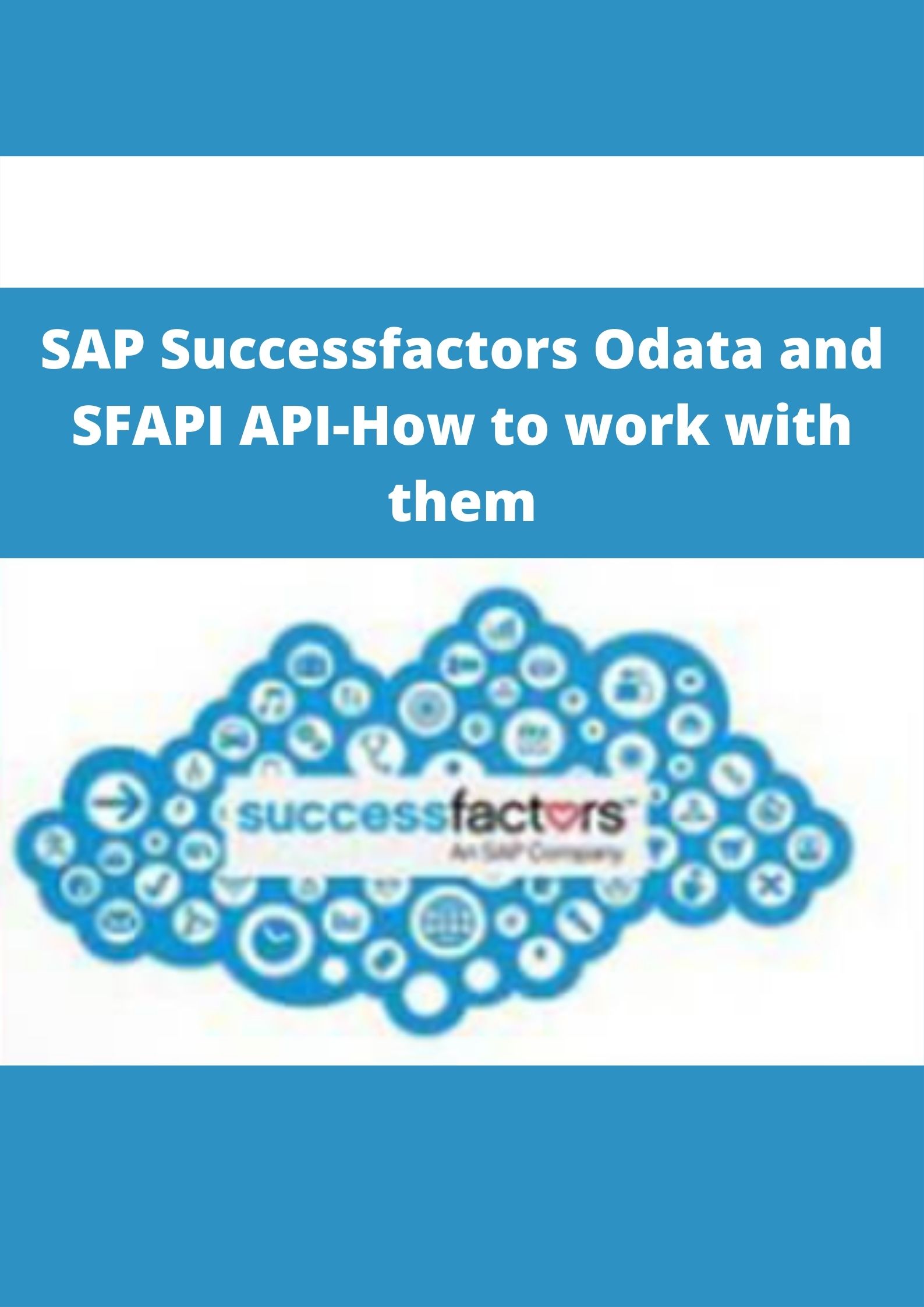SAP Successfactors Odata and SFAPI API-How to work with them
$84
Shopping Instructions:
- DISCOUNT 15% : SHOP15
- Product Delivery: Within 1 – 12 hours after purchase.
SAP Successfactors Odata and SFAPI API-How to work with them
Sale Page : -/-
Description:
A must have a course to work with any type of integration with SAP Successfactors. What you will learn:
Students could run SFAPI, OData API with confidence and clarity. Students will be able to clearly understand the various technical aspects of running the Successfactors API.
You can create, read, Update, Delete, Update, batch operations on Successfactors objects.
With the understanding given during the course, various scenarios that require SAP Successfactors integrations can be understood and developed.
The only course that deals with the technical aspects of the SFAPI and OData API of SAP Successfactors know how and execution.
DISCLAIMER: This course is not created in any way in affiliation with SAP. This is the only work of the technical information collected during years of working with the Successfactors APIs.
Demonstrations and Sessions have been held in the course on the APIs of the SAP Successfactors Employee Central Foundation and HCM Suite; the Successfactors core.
Requirement
Understanding of the English language.
PC with internet.
To practice the use cases and demo sessions provided during the course, students would need access to the Successfactors instance.
There is no need to have any integration tools to run the use cases and / or API calls demonstrated and discussed in this course.
Description
A complete workshop!!!
This course discovers the SFAPI and ODATA APIs, which are the interoperability Mechanism offered by SAP Successfactors.
It will show how the various aspects of APIs, endpoint URLs, input / output parameters for API calls, access permissions, SFAPI and OData APIs, how to run them, various concepts around effective dated entities, operations like query, update (both variants merge and replace), upsert, delete, etc. can be searched and operated.
With this course, you will be able to gather the practical knowledge of working with APIs in depth, a necessity for any Successfactors consultant, Solution Architect and for that matter an enviable armor for SAP HCM Successfactors Functional Consultants.
Several use cases are also covered in the course in which it practically demonstrates how APIs can be called to meet the necessary goal of the API.
The years of practice and challenges that were encountered when calling the APIs, creating the objects, demystifying various aspects such as how to collect the values that a field should take; all have been placed on the course with the only ideology that a person should be able to start from the beginning and reach the end.
Also all learning is done from open source tools like SOAP ++ and Postman community editing and there is no need for Boomi / PI as paid tools for this course.
Below is the course content:
Section 1: Introduction
- Implementation
Section 2: SFAPI: Successfactors SFAPI URI and wsdl
- What is the data center URL
- Importance of data center URL
- Data center URL collection
- Data center URL continuation collection
6.* Other steps, SFAPI URL and others
- SFAPI URL formulation
- Open system.
- SFAPI enabled?
Section 3: configuring the Soap user interface
- SOAP UI download and install
- Changes to SOAP UI settings in view of Successfactors TLS v1.0 deactivation
Section 4*: creating an API user ID to make SFAPI calls
- Creating a user ID for SFAPI calls
- Creating user IDs through Option 1 (provisioning)
- API user ID creation via option 2.1 (Successfactors application UI)
- API user ID creation option 2.2 (import employee via SFSF application UI)
Section 5*: setting the password for the API user
- Set passwords for previously created API user IDs
- Password setting for API user-option 1.1
- Password setting for API user-option 1.2
- Setting the password for the API user-option 2
- User password settings-option 3 and 4
- Considerations when SSO is enabled
- Considerations for SSO: enable the loginMethod field
- Make the first SFAPI call !
Section 6: SFAPI methods and parameters
- SFAPI (methods)
- Understanding SFAPI wsdl
- Preparing for hands on Sessions in API calls
- Configuring the API user login exception
- Make the call to SFSF to retrieve the list of SFAPI SFObjects
- Performing the SFAPI call for session management and metadata inspection methods
- SFAPI call for Data Query category (query and query more)
- SFAPI call for data manipulation category (upsert call)
- SFAPI call for asynchronous operations
Section 7: OData: tools for making the OData call
- Postman settings
- SOAPUI: make REST calls from SoapUI
- Chrome advanced REST client
- Chrome / Firefox Browser
Section 8: Odata basics (in relation to the Successfactors Odata service)
- Introduction of Odata and structure components
- OData Basics: service document vs. Service metadata document
- OData basics: entity metadata comparing documents with other documents
- OData basics: how to collect service, service, and entity metadata documents
- OData basics: description of the service metadata document – EntitySets, EntityType
- OData basics: description of the service metadata document – AssociationSet and Type
- OData basics: description of the service metadata document – navigation property
- OData basics: description of the service metadata document-feature imports
- OData basics: entity metadata document description
Section 9: OData URI
- OData URI: introduction and how to collect the service root uri for Odata calls
- OData URI: URI and its components – all components
- OData URI: URI and its components – resource path-Part I
- OData URI: URI and its components-resource path – Part II
- OData URI: URI and its components-query options
Section 10: OData query options
- OData query options: $orderby
- OData query options: $top and SK skip
- OData query options: combinado top + SK skip combined with $orderby
- OData query options : filtro filter-introduction
- OData query options: logical operators supported by $filter
- OData query options: $filter-supported arithmetic Operators
- OData query options: grouping, custom, and string operators supported by $filter
- DateTime and DateTimeOffset DataType fields
- OData query options: $filter – supported DateTime operators-Part I
- Time DataType Fields
- OData query options: $filter-supported DateTime Operators-Part II
- OData query options: $filter-supported Numeric Datatypes
- OData query options: $filter-supported Boolean Datatype
- OData query options :EXP expand
- OData query options: $format
- OData query options: $select
- OData query options: $inlinecount
Section 11: OData API user permissions
- OData: create an API user and assign the password
Section 12: effective date entities
- Effective date entities – What are they?
- Effective dated entities: how are they defined?
- Effective dated entities-the concept
- Effective dated entities-advanced concept
- Different ways in which data can be entered into Successfactors
- Fromdate, toDate and asofdate concept for effective date entities
- Fromdate, toDate and asofdate concept for entities with advanced effective date
- Initial data entry: impact on effective dated objects
- Correction mode data entry: impact on effective dated objects
- Data entry edit mode: impact on effective dated objects
- Insert and delete mode data entry: impact on effective dated objects
Section 13: effective behavior of dated entities with navigation
- Effective behavior of date entities with navigation: rules
- Effective behavior of date entities with navigation: advanced navigation concepts
Section 14: effective dated entities: how can they be consulted
- Effective date entities: several parameters available for consultation
- Effective dated entities: queries involving from / to / comoDeFecha
- Entities with effective date: query involving start / endDate
- Effective dated entities: the logical system follows when from / to / asOfDate are present
- Effective dated entities: lastmodifiedondatetime parameters rules
- Effective dated entities: filter by lastModifiedDateTime scenarios part I
- Effective dated entities: filter by lastModifiedDateTime scenarios Part II
- Effective dated entities: filter by lastModifiedDateTime scenarios Part III
- Effective date Entities-filter by lastModifiedDateTime-final algorithm
Section 15: effective date entities-behavior with $expand
- Effective behavior of entities dated with exp expand-rules
- Effective behavior of dated entities with exp expand-additional understanding-partI
- Effective behavior of dated entities with exp expand-additional understanding-partII
Section 16: OData API: push Operations
- OData APIs: push Operations: Overview
Section 17: OData API: insert operations: INSERT
- Section overview: OData API: INSERT
- INSERT: does the operation support the entity, the required fields, the URI, the HTTP verb
- INSERT: request body: are all fields supported for Operation?
- INSERT: allowed Field values-data types and MaxLength
- INSERT: allowed Field values-PickLists
- INSERT: allowed Field values-MDF objects
- INSERT: allowed Field values-navigation links
- INSERT: allowed Field values-OptionId or ExternalCode (PickList values)
- INSERT : perform the insert into the entity through the OData API
- INSERT: can multiple calls be published in an OData call
Section 18: OData API: link operations
- OData APIs: overview of links
- OData APIs: query operation on links / navigation
- OData APIs: create operation on links
- OData API: remove operation on links
- OData APIs: update operation on links
Section 19: OData API: push Operations: Update
- Update: perform the update on the entity via the OData API
- Update: perform a replacement operation
- Update: perform a merge operation
- Update: some additional differences between the replacement and update operation
Section 20: OData API: insert operations: UPSERT
- UPSERT: introduction and initial call
- UPSERT: demystifying the user and perpersonal relationship: a specific challenge
- UPSERT: additional discussion about Upsert
- Upsert: processing parameter)
- UPSERT: What do all entities support PurgType = full
- Upsert: processing parameter)
- Upsert: Purge type behavior with Entity’s no_overwrite property
- Upsert: EmpGlobalAssignment object description
- UPSERT: suppressUpdateOfIdenticalData processing parameter
- Upsert: fileLocale processing parameter
- Upsert: multiple requests in one call
- Upsert: multiple online entity types in one call-Part 1
- Upsert: multiple online entity types in one call-Part 2
- Upsert: Avenue for improving the performance of the Upsert call
Section 21: OData APIs: operation: DELETE
- DELETE: deleting entities
Section 22: Bonus
- Use case: creating and querying PickList entries
- Use case: function import: add or remove users from static group
Who is this course for
Anyone interested in how SAP Successfactors Odata and SFAPI work.
The course details SFAPI and OData objects, their properties, operations, and their executions.
A must-have knowledge package for SAP Successfactors consultants and solution architects who need to design solutions on top of the various APIs offered by Successfactors.
Functional Consultants who want to have ownership and control over Successfactors objects and foster their opinion on how integrations are designed.
Please kindly contact us if you need proof of item.
1 review for SAP Successfactors Odata and SFAPI API-How to work with them
Add a review Cancel reply
Related products
Personal Development
Personal Development
Personal Development
Personal Development
Personal Development
Personal Development
Personal Development












Deven Prosacco –
Fast shipping and as described!! Thanks! | SAP Successfactors Odata and SFAPI API-How to work with them